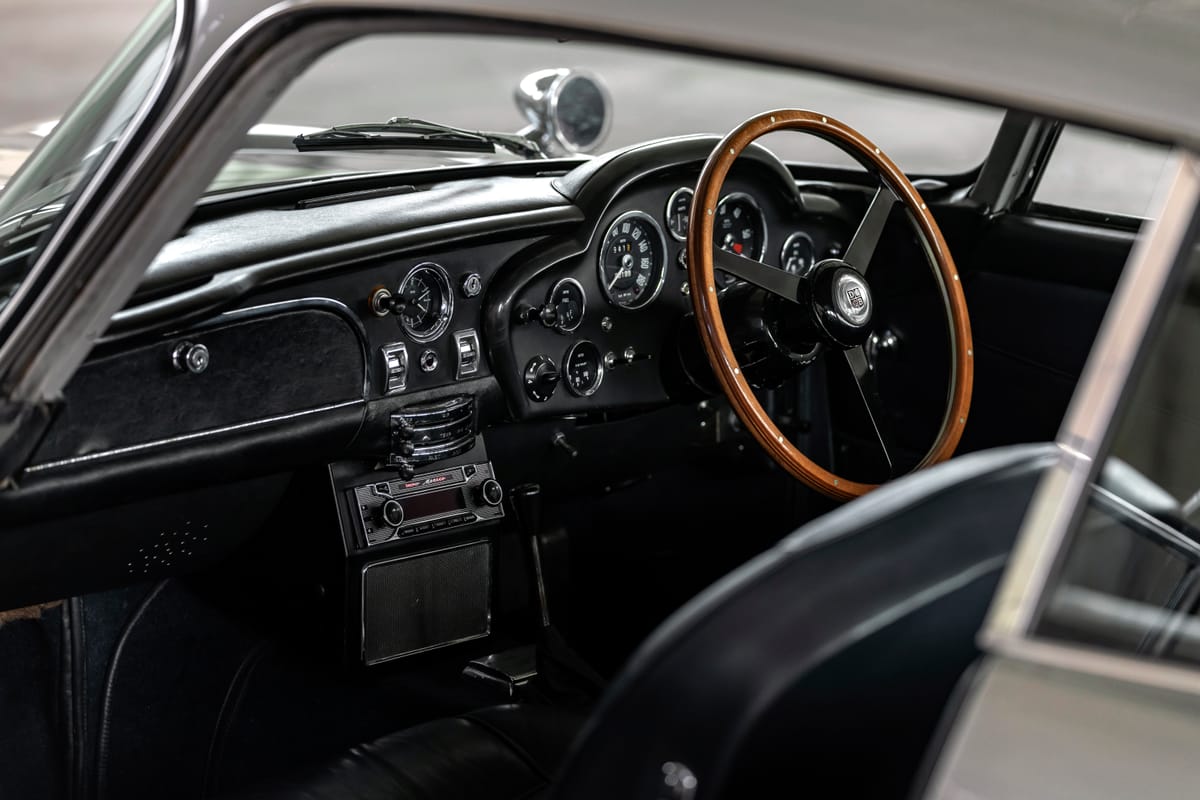Aston Martin DB5
The Aston Martin DB5, launched in the 1960s, has become an automotive icon, famed for its role in James Bond films. With only 1,059 units produced, its rarity enhances its allure, making it a symbol of luxury and style.

The classic car market has witnessed an extraordinary resurgence in recent years, especially when it comes to vintage luxury models. As modern vehicles become more automated, high-tech, and increasingly homogeneous, car enthusiasts and investors are turning back to cars that evoke nostalgia, timeless design, and mechanical purity.
Among the most notable beneficiaries of this revival is the Aston Martin DB5—a car whose allure has only grown since its debut in the 1960s. Iconic for its appearances in James Bond films, the DB5 has cemented its place as a symbol of British elegance, engineering, and luxury. Today, it represents one of the most sought-after vintage models, with values at auctions soaring to unprecedented levels.
The Aston Martin DB5 is much more than a car—it’s a cultural icon, a masterpiece of engineering and design, and a symbol of timeless luxury. Introduced in 1963, the DB5 represented the pinnacle of British automotive craftsmanship at the time and remains one of the most celebrated vehicles in history. This grand tourer, renowned for its elegant design, cutting-edge technology, and association with the world’s most famous secret agent, James Bond, has etched its place in the annals of motoring legends.
The DB5’s journey began with its predecessor, the Aston Martin DB4, which had already set a high standard for grand tourers. However, Aston Martin sought to push the envelope further. With the introduction of the DB5, they managed to create a vehicle that wasn’t just an upgrade but a significant evolution in terms of performance, luxury, and sophistication. The name "DB" comes from David Brown, the owner of Aston Martin at the time, whose vision for the company was rooted in producing cars that embodied both elegance and high performance. The DB5 was a manifestation of that vision, taking everything great about the DB4 and refining it even further.
Aston Martin DB5. Credit: Aston Martin
The car was designed by Italian coachbuilder Carrozzeria Touring, which employed its innovative “Superleggera” (meaning "super-light") construction method. This technique used aluminium body panels attached to a tubular steel frame, reducing the vehicle’s weight without compromising its structural integrity. The result was a car that not only looked sleek and elegant but also performed exceptionally well. The flowing lines of the DB5’s body, with its subtle curves and long bonnet, exuded a sense of effortless speed and luxury. Every detail of the design was carefully considered, from the distinctive front grille to the chrome accents that lined the windows and lights.
Under the hood, the DB5 housed a 4.0-litre straight-six engine, which was an upgrade from the DB4’s 3.7-litre unit. This larger engine delivered 282 horsepower, making the DB5 one of the fastest cars of its time. Capable of reaching a top speed of 145 miles per hour, the DB5 could accelerate from 0 to 60 mph in around eight seconds—an impressive feat for a grand tourer in the early 1960s. This made the DB5 not only a vehicle of beauty but also a car that could deliver exhilarating performance, whether cruising along a coastal road or sprinting along the autobahn.
The DB5 was equipped with state-of-the-art technology for its time, starting with its ZF 5-speed manual gearbox, which provided smooth and precise gear changes. For those who preferred a more relaxed driving experience, a 3-speed Borg-Warner automatic transmission was also available. Its braking system, featuring Girling disc brakes on all four wheels, was advanced, offering reliable stopping power—a feature that set it apart from many of its contemporaries, which still relied on drum brakes.

Inside, the DB5 was as luxurious as it was powerful. The interior was hand-finished, with Connolly leather upholstery covering the seats, dashboard, and door panels. The attention to detail was meticulous—every stitch, every panel, and every piece of chrome trim was crafted to perfection. The walnut dashboard added a touch of classic British elegance, while wool carpets provided comfort and refinement. Aston Martin paid great attention to the car’s ergonomics, ensuring that the driver had easy access to all controls and instruments. The dashboard featured a comprehensive set of gauges, including a tachometer, oil pressure, water temperature, and fuel level indicator, allowing the driver to keep a close eye on the car’s performance. Other standard features included electric windows—a rarity at the time—reclining seats, and even a fire extinguisher mounted in the cabin, a reflection of Aston Martin’s focus on both luxury and safety.

Though only 1,059 DB5s were built, Aston Martin offered several variants to cater to different tastes and requirements. Among them was the DB5 Vantage, a high-performance model with triple Weber carburettors, which increased the engine’s power output to 325 horsepower. Only 65 Vantage models were produced, making them particularly rare and desirable among collectors today. Another variant was the DB5 Convertible, with just 123 built, offering open-air motoring for those who wanted to experience the thrill of driving with the wind in their hair. The DB5 Shooting Brake, a rare station-wagon-style version, was produced in even smaller numbers, with just 12 units built, offering practicality without sacrificing style or performance.
Of course, the Aston Martin DB5's place in automotive history is inextricably tied to its role in the James Bond film franchise. In 1964, the DB5 made its debut in Goldfinger, driven by Sean Connery as 007.

This marked the beginning of what would become one of the most iconic partnerships in cinema history—the Bond car and the DB5. The car was equipped with an array of gadgets that were pure fantasy at the time, including machine guns hidden behind the front indicators, a bulletproof rear shield, rotating number plates, and an ejector seat. These features, while impractical for the real world, captured the imagination of moviegoers and helped to cement the DB5 as a symbol of sophistication, adventure, and intrigue.
The DB5's role in Goldfinger was so successful that it became an integral part of the Bond universe, reappearing in later films such as Thunderball (1965), GoldenEye (1995), Tomorrow Never Dies (1997), Casino Royale (2006), Skyfall (2012), and No Time to Die (2021). Through these films, the DB5 became a global symbol of British elegance and engineering, elevating its status beyond the realm of classic cars and into the realm of cultural icons. No other car in the Bond franchise has achieved the same level of recognition, and it is often referred to as "the most famous car in the world."
The DB5’s cultural significance extends far beyond its cinematic fame, though. It has become a highly coveted collector's item, with prices for well-preserved or restored models regularly surpassing $1 million at auctions. Its rarity, combined with its association with James Bond and its timeless design, ensures that the DB5 remains one of the most desirable cars on the planet. In recent years, Aston Martin has capitalised on the DB5’s enduring appeal by producing "Continuation" models—modern recreations of the original DB5, built to the exact specifications of the Goldfinger movie car, complete with functioning gadgets.

These continuation models, of which only 25 were produced, sold for over £2.75 million each, highlighting the DB5’s status as a piece of living history.
The DB5's influence extends even to Aston Martin’s modern lineup. Many of the company’s contemporary models, such as the DB11 and the Vantage, draw inspiration from the DB5’s classic design, incorporating elements like the long, sloping bonnet and the distinctive grille. However, while the aesthetics have evolved, the spirit of the DB5—its combination of elegance, performance, and luxury—remains at the heart of Aston Martin’s brand identity.
Despite being over 60 years old, the DB5 continues to capture the imagination of car enthusiasts and collectors around the world. Its design, engineering, and cultural impact make it a car that transcends generations, appealing to those who appreciate both its historical significance and its sheer beauty. In a world where car designs come and go, the Aston Martin DB5 remains a beacon of timeless automotive excellence.
In conclusion, the Aston Martin DB5 is more than just a car—it is a legend. From its innovative design and powerful engine to its luxurious interior and enduring cultural significance, the DB5 represents the best of what a grand tourer can be. Its place in history is not just due to its role in the James Bond films, but because it epitomises an era when cars were built not just for transportation, but for the joy of driving and the art of craftsmanship. As a symbol of British engineering, luxury, and style, the DB5’s legacy will continue to live on for generations to come, ensuring that it remains one of the greatest cars ever made.





